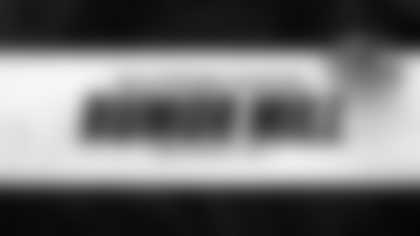When the Ravens drafted Hayden Hurst in the first round, Mark Andrews, sitting at home with his family, didn't cross Baltimore off his list of possible destinations.
"The Ravens have always had a history of loving their tight ends, so it was never out of the picture for me," Andrews later said.
Sure enough, in the third round, the Ravens selected Andrews with pick No. 86 overall. For the third time in the past nine years, Baltimore took tight ends in the same class.
"It's exciting having Hayden and I on the table, and being able to work off each other is going to be a big thing," Andrews said. "We're going to be able to grow and compete with each other and have healthy competition where we're able to grow as players."
So how will the rookies complement each other?
The 6-foot-3, 250-pound Hurst is a jack-of-all-trades tight end. He's a strong blocker and top-notch receiver, which allows Baltimore to use him in any situation to keep opponents guessing.
Hurst has the quickness, strength and toughness to be a top-notch receiver, especially over the middle and in picking up first downs. He can stretch the seam of opponent's defenses while also doing a lot of the dirty work underneath.
"I think it's a great fit," Hurst said. "In our '12' personnel, we get in there, we kind of work off each other and feed off each other's energy. I'm excited to get out there and play with him."
Andrews, meanwhile, is currently more of a big-bodied wide receiver since he mostly lined up wide in Oklahoma's spread offense, where he caught 22 touchdowns in three seasons. If the Ravens are looking for a big target in the red zone, Andrews is the guy.
Standing in at 6-foot-4, 256 pounds, he has the size to be a blocker, and said he intends to work diligently at that part of his game, but he's likely going to be asked to do more as a pass-catcher than people-mover at this time.
"Hayden is an extremely aggressive player," Andrews said. "I think we can work off each other and use our strengths and whatnot. … It's going to be tough on defenses to be able to game-plan for us."
The rookie tight ends should get more offensive opportunities than their predecessors. Williams set the franchise record for most receiving yards (268) by a tight end in his rookie season. Hurst or Andrews could break that mark.
When Todd Heap (first round) was drafted in 2001, he was behind Shannon Sharpe. When Ed Dickson (third round) and Dennis Pitta (fourth round) arrived in 2010, they studied from Heap for a year. When Maxx Williams (second round) and Nick Boyle (fifth round) came in 2015, Crockett Gillmore led the way.
With the departure of Benjamin Watson in free agency, the Ravens have a lot of opportunities for receiving tight ends. Watson led Baltimore in receptions (61) last year and saw the second-most targets (79). Boyle caught 28 passes for 203 yards and Williams caught 15 for 86 yards.
It's only been a few days and they're still in shorts, but Hurst and Andrews made a good first impression at Ravens rookie minicamp.
Head Coach John Harbaugh said the first thing that stuck out to him about his rookie tight ends were their "excellent" hands. He also noticed their very good body control to get in and out of breaks and shield off defenders. He liked their feel for coverage.
The other big thing that Harbaugh pointed to is their willingness to learn. They know they could have a big role together this season.
"They're the kind of guys that want to know everything," Harbaugh said. "They want to know every answer, they want to know every detail of every play, sometimes to the point where you just want to say, 'Hey! Just play fast. You're not going to know everything right now.' But they're conscientious guys that way."



















